Blog Tag: MEAN Stack
Six Powerful Web Applications You Can Build with Node.js

Did you know Node Package Manager or npm is the largest software registry on the web? This is coming from a web technology that wasn’t available on until 2009. Node has built a strong and ever-growing community & ecosystem around itself. Stack Overflow’s developer survey for 2018 shows that Node and two of its frontend counterparts, React and Angular, are the most used technologies by developers and made many companies actively looking to hire Node.js developers.
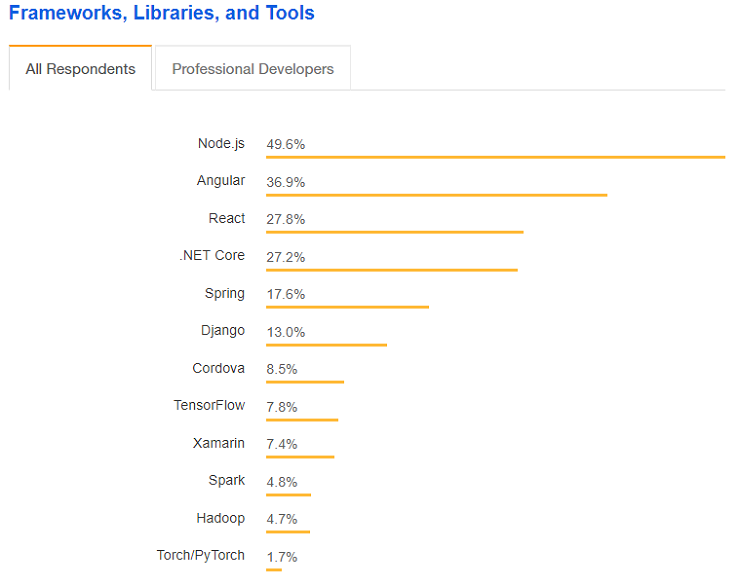
So what made Node.js so popular in such a small frame of time and why so many technology firms are talking about Node.js development services.
Well there are many benefits to Node over other backend technologies. The profound being its highly scalable architecture. I have already covered benefits and architecture of Node in the previous blog. In this blog, I will capture a few use-cases of web applications where Node finds the most relevance at.
Of course, real-time applications we interact with on a daily basis won’t be so many unless for Node’s scalable architecture.
1. Building Real-time Application
Uber’s extravagant ambition to make transportation as reliable as running water is reminiscent of the vast amount of IT resources that powers it and a reliable backend technology that powers those servers called Node. It’s not just Uber, thousands of enterprise and tech startups are building a substantial part of their backend infrastructure in Node to make way for real-time applications.

I mean they were still building real-time application before the time Node came. Those applications were inefficient and uneconomical because of higher resource utilization. When PayPal rebuilt one of their Java and Spring based applications using Node, this is what their blog cited.
“The node.js app was built almost twice as fast with fewer people, written in 33% fewer lines of code, constructed with 40% fewer files, processing double the requests per second, and measured 35% decrease in the average response time”
The technicalities how Node achieves this feat, you must refer my last blog on Node.js architecture. So next time you see an app updating data in real-time, think Node.js is behind it.
2. Server-Side Rendering (SSR) of JavaScript Application
Let me ask you a question. Can web apps written in JavaScript function without server-side rendering by a Node server? Yes, they can since web browsers can render JavaScript in addition to HTML and CSS on the client side. Then, why at all we need server-side rendering in JavaScript applications? The reason is search engine optimization.
Because a Single Page Application has a single URL for all the instances; it needs a router to generate fresh URL for major instances. However, responses of, Angular Router for example, is in pure and; often, async JavaScript, which web search crawlers such as Bingbot and Googlebot can’t comprehend.
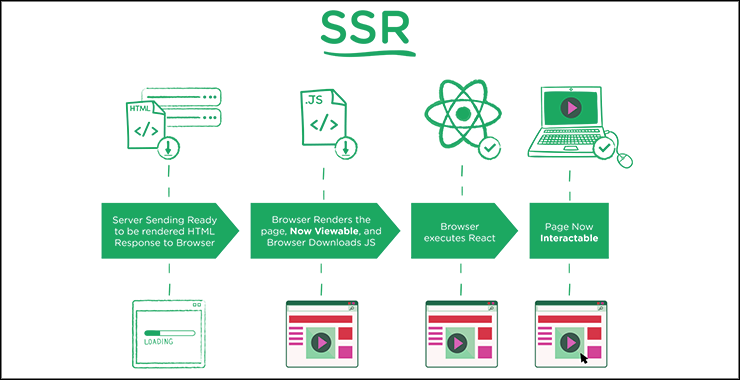
Therefore, web developers often have to rely on bringing Node.js developers to setup a Node server to enable server-side rendering on their SPAs. Since JavaScript is rendered server-side, web crawlers can crawl the instances of an SPA as they would pages on a dynamic website.
All major Node.js frameworks including Express and Koa support SSR.
3. Exposing MongoDB Data in MEAN Stack
Document databases such as MongoDB use JSON documents in order to store records; just as tables and rows store records in a relational database. Here is an example of a JSON document:
{ '_id' : 1, 'name' : { 'first' : 'John', 'last' : 'Backus' }, 'contribs' : [ 'Fortran', 'ALGOL', 'Backus-Naur Form', 'FP' ], 'awards' : [ { 'award' : 'W.W. McDowell Award', 'year' : 1967, 'by' : 'IEEE Computer Society' }, { 'award' : 'Draper Prize', 'year' : 1993, 'by' : 'National Academy of Engineering' } ] }
If you’re using Rails, you would convert from JSON to binary models, then expose them back as JSON over the HTTP when the data is consumed by React.js, Angular.js, etc., or even plain jQuery AJAX calls.
When using Node, though, you expose your JSON documents with a REST API for the frontend to read. A JSON database returns query results that can be easily parsed, with little or no transformation, directly by JavaScript—reducing the amount of logic you need to build into your application layer.
4. Handling Concurrent Streams to MongoDB
MongoDB access is a blocking operation, which could be a bottleneck to your Angular application when working on the MEAN stack since Node can virtually handle millions of requests at a time. This fallacy causes great strides of discontent with overall working of an application that gets thousands of concurrent requests.
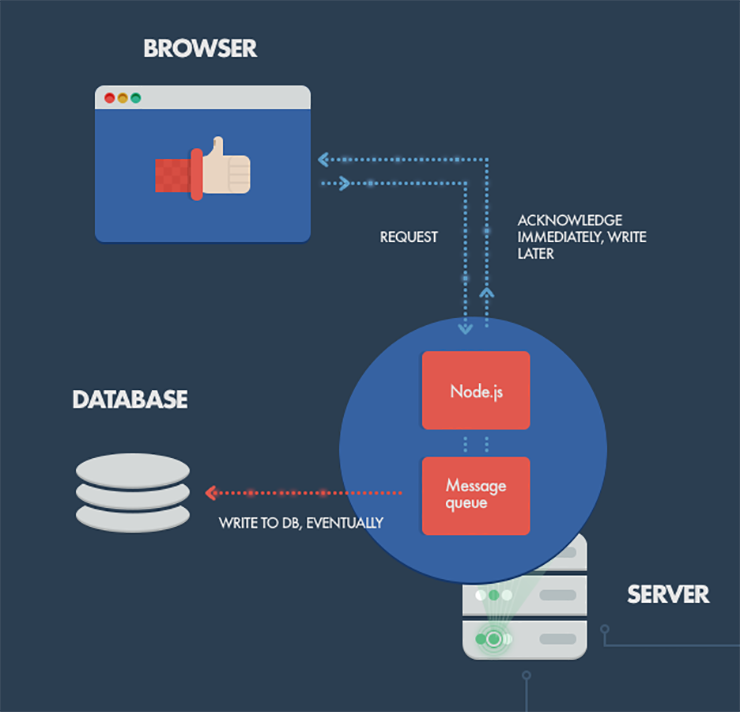
Node can turn out to be savior in those instances as it can accept the client’s request before the write operation on the MongoDB database. This approach is appropriate in applications where client doesn’t need instant confirmation on his actions leading to writes on the database. Node, in the meanwhile, can maintain system responsiveness under a large load.
5. Building Proxy Servers
Node.js is easily employed as a server-side proxy where it can handle a large amount of simultaneous connections in a non-blocking manner. It’s especially useful for proxying different services with different response times, or collecting data from multiple source points.
An example: consider a server-side application communicating with third-party resources, pulling in data from different sources, or storing assets like images and videos to third-party cloud services.
Although dedicated proxy servers do exist; using Node instead might be helpful if your proxying infrastructure is non-existent or if you need a solution for local development. By this, I mean that you could build a client-side app with a Node.js development server for assets and proxying/stubbing API requests; while in production you’d handle such interactions with a dedicated proxy service (nginx, HAProxy, etc.).
6. Real-time Dashboards
Node is prefect suit for building dashboard for displaying real-time data to users. For example, stock trader’s dashboard, application monitoring dashboard (Node-with-web-sockets), and system monitoring dashboard.
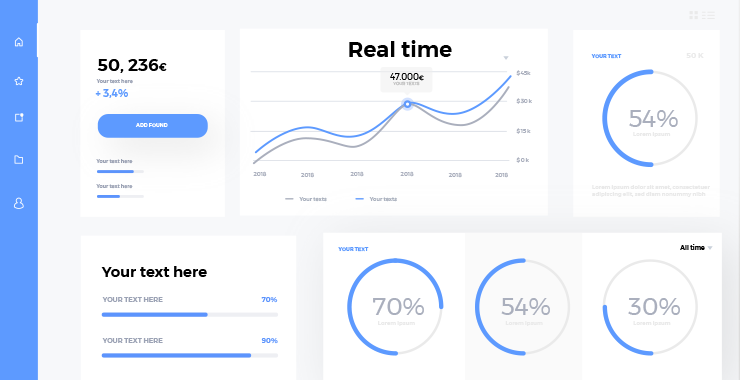
With the Node.js event loop, we can build powerful web dashboards to check service statuses in asynchronous manner and push data to clients using websockets.
Node matters more than any web technology ever around
Node.js is not only revolutionizing backend web development; it’s also bringing performance to the frontend application build in React, Angular and other frontend JavaScript frameworks and libraries. It brings noteworthy engineering to client-side. It plays an integral part in development of overall JavaScript ecosystem; the perfection of modern JS frameworks and, of course, technology stack building the future of web development—MEAN.
Secure Your Web App Against Modern Web Threats Using MEAN Stack

MEAN stack brings full stack development under purview of a single programming language, JavaScript. Alongside bringing the best of the frontend and backend technologies under a single basket, MEAN stack inherits security vulnerabilities each of these technologies are susceptible to. Some of the security threats augment when these technologies play together inside the framework. If those vulnerabilities are not subsided by the MEAN stack developers at the time of writing code, they will put the entire organization using those applications at jeopardy.
For example, MongoDB is a NoSQL database and an integral part of the MEAN stack. A common myth is NoSQL means no injections. In reality, MongoDB has a concept of query selector operators. These operators start with a dollar sign: $gt means greater than, $ne means not equal to, $not for negation, etc. If an attacker can inject these queries selector operators into the query, he can alter the logic of that query.
Here the presence of Express.js in MEAN stack makes the situation worse; it acts as a catalyst to NoSQL Injections. When Express sees nested URL encoded parameters in an input, it’s going to automatically parse them. This allows a person to inject a query operator into hid statement and alter the logic of this operation. And that’s only a part of the problem with MongoDB and there are three more technologies with their own share of risks and vulnerabilities.
Let’s take a look at the all the technologies inside MEAN stack and what are the potential security risks they can expose your application to.
1. MongoDB
As I said, MongoDB is immune to SQL injections but not every type of injections. In fact, MongoDB are more susceptible to something called Query Selector Injections or NoSQL Injections than MySQL is to SQL injections. The JSON documents with some neat, little tricks can be altered to achieve some malicious results. This as I mentioned above involve built-in logic operators to alter queries.
Another problem with MongoDB is this that it doesn’t force authentication that means that five year old hacker living next door can query the database with little to no difficulty. The icing on the cake is MongoDB’s optional HTTP and REST interface, which not only puts the database and the sensitive information inside it on the public domain but also the underlying file system.
To make sure, your database is not accessible to anybody make sure you disable HTTP and REST interface. You can configure /etc/mongodb.conf file’s bind_ip, auth,httpinterface, and rest options to contain access to the database and, thus, secure the MongoDB instance as demonstrated below.

Ransom-wares targeting the insecure default conf file on these servers exploited more than forty thousand instances of MongoDB by January 2017.
2. Node
Node.js facilitates the development of web applications with broad backend capabilities:server and networking capabilities. It makes way for real-time bidirectional communications back and forth from server and client. Node.js is a standalone package of Google’s V8 JavaScript engine and; thus, works outside of a web browser.
Developers love Node.js as it allows creating HTTP web servers while building the web applications. The very reason MEAN stack exists; Node.js isn’t without its share of security vulnerabilities. In fact, it inherits all security flaws JavaScript suffers from. In addition, the ability to execute at the server exposes it to a new set of attack vectors. Nevertheless, the CVE database compiles an up-to-date list of Node.JS vulnerabilities.
In a nutshell, full stack development may be the epitome of DevOps; nevertheless it necessitates stringent adherence to protected application development practices. The MEAN stack, and any stack for that matter—be it LAMP, .NET, or MEAN—needs apt controls to make sure that security is baked into an application since the initial phases of development. In the MEAN stack, complete vulnerability assessment and monitoring for web applications, databases, and servers is required.
3. Express
A minimal, flexible web application framework built around Node.js, Express hasmany features that simplify web and mobile application development. Express.js is to Node what Ruby-on-Rails or Sinatra is to the Ruby language.
Unluckily, the framework is susceptible to numerous injection and cross-site attacks and is vulnerable to all of Node.js’s core vulnerabilities.
For example, in MEAN stack, session state client-side stored in JSON Web Token (JWT) is encrypted. Thus, persistent session data server-side makes the application scalable when deployed in clustered servers. However, this handiness comes at a cost, explicitly the incapability to nullify a user’s session. Of course, you can expire the cookie afteryet the server will accept a replayed cookie even when you purged the cookie.
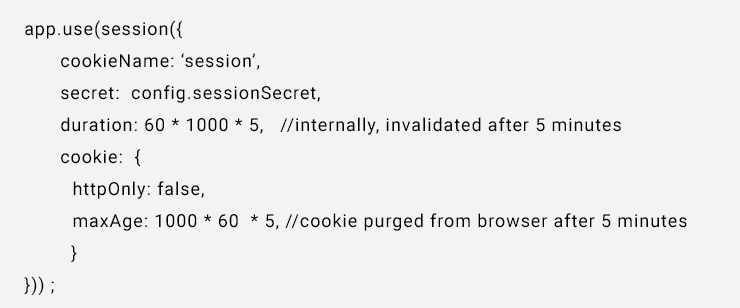
This issue can be moderated by keeping an inner expiration value within the session cookie.
Another problem with Express is this that the Csurf plugin is omitted from GET, HEAD, and OPTIONS methods. Csurf plugin protects web application from cross-site request forgery (CSRF). That is, an application with GET routes will not be protected from CSRF attacks.
That means the below code and the resulting app is vulnerable to CRSF because of the GET part.
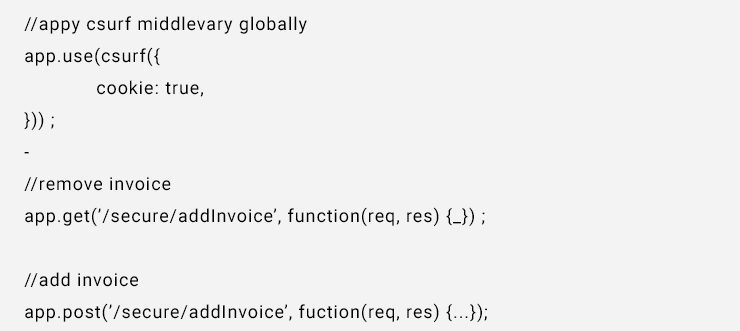
To mitigate this, developers should do one of the following:
- Change the /secure/remove Invoice route to use the POST method
- Remove GET from the ignore Methods option
- Apply the Csurf middleware inline to each route requiring protection rather than globally with use()
4. Angular
Angular has inherent Strict Contextual Escaping service ($sce) by default. This service secure Angular from malicious HTML tags (e.g., <script>, etc.), attributes (e.g., onmouseover, onerror, etc.), and URI protocols (e.g., javascript) from data rendered as HTML with the ng-bind-html directive.
The problem is Strict Contextual Escaping service ($sce) can turned off by sceProvider.enabled() method globally while $sce.trustAs methods turn it off per-instance. In short, Angular is quite vulnerable to cross-site scripting (XSS) attacks when binding insecure data as HTML.
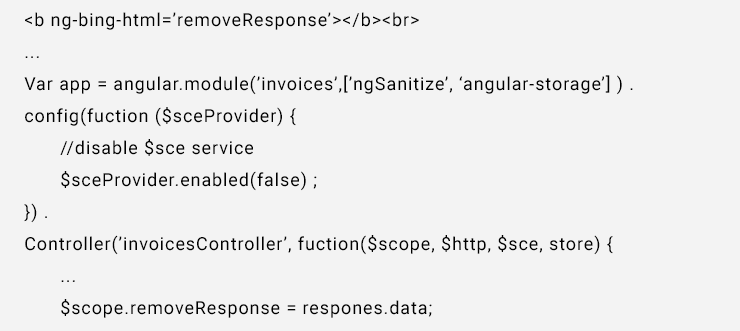
The easiest method around this vulnerabilities is to enable $sce service for untrusted bound to the ng-bind-html directive. Removing the $sceProvider.enabled(false) method from the excerpt above means the malicious onerror attribute will be sanitized appropriately.
Another security risk with Angular and thus MEAN stack applications is expression injection. An attacker can enter a curly bracket to Angular template to modify expressions. Aforementioned functions do not take in account expression injection using curly brackets.
To mitigate the risk, sanitize curly brackets from insecure input or by prevent the input from being written inside an Angular template by reducing the scope of the ng-app directive.
Conclusion
MEAN stack development is the epitome of DevOps that forbids insecure development practices. Besides, this approach entails sufficient controls to make sure that security is an integral part of every stage of development.
How Will MEAN Stack Development Add Value to Your Business?

MEAN stack garners interest of many technology firms that have existing investment into JavaScript realm whether in the form of software infrastructure or human resources. In addition, SMEs, in various industry verticals with little to no investment in web technologies, are looking at MEAN stack as the web development stack to replace their existing, hard-to-maintain apps in LAMP stack. After all, MEAN stack is everything businesses have been asking in a development stack. Isomorphic coding makes way for seamless interoperability between the two ends, lower utilization of human resources, re-usability of software components, cost-reduction and rapid cloud deployment of business apps.
Further, MEAN Stack is JavaScript, front and backend, which means a JavaScript developer can switch between client and server side of a business application without much fuss. No doubt, many businesses are looking at MEAN Stack development to build fresh business apps or replace existing ones. It brings a number of business benefits.
It Leverages on Existing Resources and Infrastructure
As JavaScript isn’t an entirely new language like Swift and Kotlin, chances are your organization will have an existing pool of JavaScript developers on whom you can leverage on. Most of the web developers are JavaScript developers by default. Even if you have to hire fresh resource, hiring web developers is easier than hiring .NET, PHP, or Java developers. They, also, cost lesser.
Since MEAN Stack is JavaScript at both the ends, a developer can easily switch between frontend and backend part of the development for a greater integration amidst the software sides. With no assigned roles, developers will work towards project completion rather than fulfilling their roles.
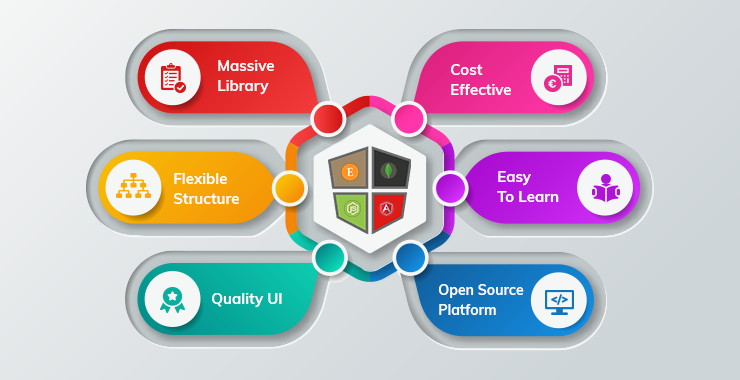
MEAN Stack is amalgamation of cross-platform technologies: MongoDB, Express.js, Angular, and Node.js and is thus cross-platform itself. The resulting code is platform independent. You don’t need specific hardware to run it and your existing IT infrastructure will work quite fine.
All in all, developing in MEAN stack doesn’t require you to make any additional investment. In most cases, your existing resources and infrastructure will do just fine.
It will Deliver the Ultimate User Experience
In MEAN stack app development, same set of developers develop frontend and backend. While in traditional web development where everything from frontend to database needs separate development teams to collaborate at various level. This often leaves too many gaps to fill at the end of each development cycle.
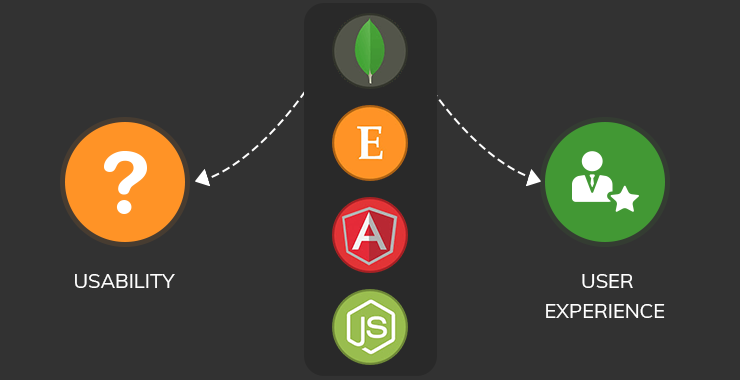
When the same developers create both side of the web application, those sides can communicate better; making way for tighter integration between the client and server side, which directly translates to top-notch user experience without too many caveats.
MEAN stack indeed adds value to your business by allowing you to develop advance business applications, which were previously were too complicated to implement or, even, impossible.
MEAN Stack Apps take Faster Time to Market
Web applications developed in MEAN stack have codebase written entirely in JavaScript. In fact, the isomorphic code functionality lets developer use the same set of JavaScript code between the components of MEAN stack. A function written for Node.js can very well be pasted into Express.js with little or no changes for the same results.

As the same team handles every part of the development from server configurations to database utilization, resulting business apps are well integrated between the software components. Even when there are voids between the components, any person of the development team, to save time, can fill it without having to collaborate with a member of other team. The same goes when developers are debugging the application before the first build.
Since the development can monitored closely in case of MEAN application, the resulting business apps tend to take far less time to market, which is exactly what businesses are looking for nowadays.
They are Easy to Maintain and Add Features to
Ask any scrum master, web development, with so many technologies involved, is a hard nut to crack when going all-out agile. Your MVP might take forever to reach the hands of your users and when it does, it might not deliver the business value you expected. At this point, businesses either abandon the app altogether or end up with weird user stories tied to strange personas, which give birth to unwanted features that your users will seldom use.
When such distorted business apps enter the market, they are costly to maintain as businesses have to keep subset of all the teams involved in the development during its lifetime in order to keep it usable or when adding unwanted features.

Applications developed in MEAN Stack addresses many complications associated with traditional web technologies by bringing every part of development into JavaScript realm. Since a single JavaScript developer can maintain your app, you don’t have to run whole lot of maintenance teams and, thus, you can maintain your business apps at the fraction of cost.
When adding new features, you just have to bring a few more JavaScript developers, which again need less resources than traditional web development. In traditional web apps to add new features, developers from various technology teams have to collaborate at various level that delays updates to your business apps.
MEAN Stack = High Performance Business Applications
In today’s date and time, businesses want their apps as high performing as any other consumer-centric app in the market. SMEs are already making strides into the world of PWAs, which are as good as mobile apps when running in a web browser environment.
For businesses looking to develop web apps that look and feel like mobile apps, MEAN is the best solution. Unlike traditional web technologies, MEAN utilizes single-page applications (SPAs).
PWAs built in MEAN stack work offline and don’t have to be constantly updated for each server request. When needed to be update; PWAs, in real-time, only update a part of the UI rather than the entire webpage unlike traditional web apps that reload after each click or tap.
Resulting real-time applications are turning out to be the gold standard of web development in the business world.
Final Thoughts
With so many benefits MEAN stack and JavaScript bring, including the cost benefits, it’s high time businesses must adopt to these gold standards of web development if they are looking for highest performance to cost ratio. Not to mention, they can finally replace their legacy web apps with those coded in JavaScript under MEAN stack. They can do so without the need of additional resources and investment in IT infrastructure.
Even if they don’t have the infrastructure in place, MEAN stack apps are easy to deploy on cloud. For additional resources, they always hire a cloud team to collaborate with their in house team.
For example, TOPS has a team of 30+ MEAN stack developers, who are ready to collaborate with you in any existing or new MEAN stack project, business apps or consumer apps.
Read More Articles:
- How Does MERN Stack Development Help In Building Web And Mobile Applications?
- An Ultimate Guide To Hiring The Dedicated MEAN Stack Developers
- Top Skills to Identify Before Hiring the Best Full Stack Developer
- Why MERN Stack Development Is A Go-To Stack For Developers?
LAMP vs. MEAN Stack: Choosing the Right Fit for your Project

E-commerce platforms like Amazon, Walmart, eBay, Alibaba, etc. provide the best user experience and that’s the reason they are always on top of trends and can respond to millions of requests within seconds.
It is all because they have used the best business model which is supported by influential technology. Have you ever thought how huge such kind of system would be? What it would take to reach such great heights?
Let’s figure it out…
To develop such a web-driven application, it should be supported by technology like Apache Tomcat as the web server and PHP and J2EE as the development framework. For years, LAMP is serving as the go-to technology as it is involved in Linux, Apache, MySQL and PHP, Perl, and Python.
Although LAMP is a good technology to deal with, it is a conventional approach to handle large database web applications. So, this technology is replaced with MEAN (MongoDB, ExpressJS, AngularJS, and NodeJS) to provide faster and more efficient web development due to JavaScript compatibility.
Since it works on the REST API, web apps can be developed by multiple front ends and the same back end; hence reduces the cost of developing the back end. Moreover, you can replace Angular.js with any framework that suits best the system.
Why MEAN is the Best For Your Enterprise Compared to LAMP?
-
MongoDB vs. MySQL:
MongoDB is considered a modern NoSQL database with a number of features and compatibilities. The strength of MongoDB lies in the relational databases compared to MySQL. When a relational database is used in MySQL, it feels like data is pushed into the table forcefully.
The system works perfectly when a single entry fits into every single format but fails badly when it doesn’t happen. On the other hand, MongoDB offers a document structure that is more flexible. So, if you wish to add new fields then simply add the field to the form, roll it up with the rest of the Data in the JSON document, and put it into the MongoDB collection.
This is great for the data dealing with dynamic data which is difficult to constrain in table form.
-
Makes your UX better with front-end
One of the major reasons to shift from LAMP to MEAN is to migrate from server-side page generation to client-side single-page applications. In MEAN, Express.js works on the REST structure and handles server-side routing and Angular.js handles client-side views.
The web-page presentation and control flow task in LAMP which was handled by PHP, Perl, or Python is taken care of by Expres.js and Angular in MEAN. Additionally, Angular.js also handles the data presentation of an application. Hence, this shift is from synchronous to asynchronous processes and page-centric views to component-oriented views of an application.
Moreover, being back with an excellent JavaScript front-end framework, the web app runs efficiently, making the UX smoother. With all such parameters in the mean stack, it enables the web application to run on desktops, laptops, mobile phones, tablets, etc.
-
The Code
MEAN makes use of Express.js and Angular.js to drive the web page presentation and control flow. Express.js serves as a controller layer, controlling application flow and organizing data for Angular.js, which handles data presentation. The importance of this is, it has simplified back-end architecture.
If you write the code for Node and decide to place it in Angular, you can do it with ease. This flexibility makes MEAN-based apps significantly easier. You can have the added benefit of having an entirely single language and don’t have to look for additional developers like a PHP expert, JavaScript experts, or front-end or back-end specialists – just a front-end javascript developer to trace all the way down the stack without having to learn another programming language.
-
Node.js simplifies the server layer
Navigating various layers of the LAMP stack is like dancing on many hats; going through the various config files with different syntaxes. This sounds a bit clumsy. But, when it comes to MEAN, it simplifies this with the help of Node.js.
Sprinkle in some JavaScript whether you want to change how your app routes requests or want to change the logic used to answer queries you want to rewrite URLs or construct an odd mapping and let Node.js do the rest of the work.
The MEAN stack in combination with Node.js keeps everything in one place and one language. You don’t have to read the pages of PHP, generate different config files, etc as in LAMP. Having everything in one place reduces the chances of errors and confusion between multiple layers.
To be precise…..
LAMP stack has surely become a conventional approach but it holds good efficiency in the market over the years as many CMS still rely on LAMP. However, MEAN Stack becoming a new player provides new and innovative ways to cut the grounds.
MEAN web development has its own list of benefits to offer for flexible web development, especially for an organization that is looking to move its focus from LAMP to an advanced Mean stack technology.
Looking to develop your next big project in MEAN? We are just a call away!! Let’s connect.
Building Modern and Scalable Enterprise Apps with MEAN Stack

Why you Should Choose the MEAN Stack For Your Modern Business Apps
Today, web programming being one of the challenging tasks, especially in case of enterprise applications, business owners look for the technology that provides high performance and scalability.
Many enterprise leaders struggle to stand tall amongst competitors – so to deal with such requirements; web development companies have to deal with the host of technologies dealing with security, networking, databases and development of server-side and client-side components.
Although there do exists much powerful communities that provide solutions for the enterprise applications but the one that enables the modern web development is the full stack solution – MEAN Stack.
MEAN – the full-form for MongoDB, Express.js, AngularJS and Node.js which was possibly the much needed and awaited revolution for the technical sphere. This stack is crafted by diverse teams and considerable community of developers is also involved that pushes forward the development and documentation of each component.
And now that MEAN Stack is so much into the world of technology and business, every growing enterprise is striving to become MEAN friendly; leaving behind plenty of solutions who are still showcasing their loyalties towards older versions! The core thing in this stack is the centralization of JavaScript as the primary programming language.
-
MEAN makes switching between client and server easier
MEAN is simple & fast and developing the apps in this technology enables the developers to write the code only in one language i.e. JavaScript for client as well as server side. Entire project can be managed by MEAN Stack formula and Node.js developer can deploy the applications on the server directly without the need of deploying it to a stand-alone server.
Additionally, it is OS independent – be it Windows, Linux or MAC. This is the best for startups and enterprises as they just have to accommodate development framework and need not think on technology.
No need to waste time in scanning libraries as all JavaScript libraries can be combined with MEAN stack. The saved time can be utilized for other productive activities which are especially crucial in the case of Startups.
-
Facilitates speedy data storage and retrieval
MongoDB in MEAN Stack uses JSON like documents throughout the database which makes it a documented database. The document structure offered by MongoDB is extremely flexible. No hardcore restriction to forcefully enter data into tables to make it usable.
For instance: addition and deletion of data can be easily done without making any complex accommodations. MongoDB doesn’t require any predefined database schemas and rules to establish field relations like MySQL.
Hence, when no large schemas are present, the system becomes efficient and fast to use and ultimately benefits the end user increasing their confidence in the start-up offering their services.
-
Uniform code from start till end
With the sufficient knowledge of JavaScript developers, you can manage your entire project with ease. JSON like queries are already available in MongoDB database, hence JSON queries can be used with Express.js and Node.js server and can have similar format for all data transfer.
However, some angular queries can be used on client side using Angular.js. Furthermore, usage of express.js and angular.js on the top of node.js results into technology stack that gives the benefit of single language means the full stack developer can manage the stack easily without learning another programming language like Python or PHP.
The experts in JavaScript can go through the entire MEAN stack themselves and can control both front-end and back-end activities. This is quintessential because developers couldn’t code, if they don’t have core knowledge of all respective technology. Other than that, page load time can be substantially reduced with node.js framework.
-
MEAN stack supports MVC architecture
When it comes to MVC, there are four aspects that help the developers for easy execution; namely – database, server, client and client UI.
In MVC, the model responds to the request for any information or data manipulation according to the controller’s instruction. The controller on the other hand responds to the system that user needs and thus gives instructions to model.
To run MVC framework complex procedures, there are numerous stack frameworks on innumerable different programming languages. With one programming language and flexible database, MEAN stack is considered as influential alternative which can compile with MVC architecture very easily.
This enhances the productivity of developers and enables the application to load faster and also assures quicker project completions.
-
Regular component updates
MEAN stack components are open source, free to use and their respective communities and support channels do come up with frequent releases and updates.
More ideas and insights from the developer community and tutorials on how to overcome hurdles to emerging challenges help keep the products and services relevant to today’s economic of scale.
The overall framework is flexible and easy to understand by making it popular with enterprises and developers.
In a nutshell, many business owners make the use of MEAN stack to revamp their existing websites. It is also ideal for other web content like blogs, media websites, data-intensive and real-time messaging applications.
If you wish to develop you next big project in MEAN, our skilled consultants will help you craft the perfect business plan.
TOPS Infosolutions is a top Enterprise Software development company, having hands-on knowledge to quickly transform your idea into world class application. Powerful IT solution – MEAN and reliable technology partner will give that ‘extra edge’ to your business.
Top Features to Look For in Angular 4.0

When Angular 2.0 was released in September 2016, it signaled a remarkable move in enterprise front-end development.
Angular.js was completely revamped with Typescript which is Microsoft’s strongly typed super-set of JavaScript. With such paradigm shift, type-safe languages such as Java, C# and Scala were welcomed into the world of modern front-end development. And now Angular 4.0 has been rolled out with the features of semantic versioning.
In order to remain on the toes with the user expectation and deliver the latest features in a mobile app, it is necessary to keep updating the technology with the latest frameworks.
Angular 4 is one such framework and core focus of this update is all about reducing the size of the code generated and to keep framework aligned with the release time. They skipped out version 3 and directly shifted to version 4 in order to sync up the Angular router’s version 3.x.
The Angular 4.0 holds SEMVER i.e. Semantic Versioning which means unbelievable improvements that should be explored by mobile app developers to see if it can handle the development process uniquely.
This kind of release is classified into major, minor or patch release based on the nature of software release. The software version will get bumped up accordingly.
A semantic version possesses following three numbers:-
- 3 – MAJOR: When they released a breaking change, they increase the first number of semantic versioning. It is increased when there is an incompatible change to the API. This is possible for Angular, if newer versions of the utilized library gets adopted to bring modifications in the API
- 2 – MINOR: When new functionality is supplemented to the existing functions and API is kept stable; there is an increase in the second number of semantic versioning.
- 1 – PATCH: When any bug is fixed without altering the API, there is decrease in the last number of semantic versioning; thus being backward incompatible.
Additionally, there is an optional – QUALIFIER specifying a version in a more accurate way.
What’s new in Angular 4.0?
- Instead of TypeScript 1.8+, Angular v4 now requires TypeScript 2.1+
- OpaqueToken, SimplyChange etc. are some of the interfaces which are either changed or removed completely
- Every latest feature in TypeScript 2.1+ are now supported by Angular 4
Typescript and the benefits of strongly typed languages
Angular 2 enabled developers to allocate types, interfaces, classes and inheritance to their front-end code. When a Static type was introduced, it ensured that any error conducted by the developers can be immediately caught by TypeScript compiler and the code written are easy to understand and simple to consume.
Features of Angular 4.0:
-
Long-term support (LTS)
At NG-Conf 2017, the team of Angular announced that version 4 is the initial version of Angular which provides Long term support. This means it is benefited for those enterprises that don’t have facility to constantly upgrade Angular entities.
-
Faster Rendering and Smaller Bundle Sizes with AOT Compilation
Ahead-of-Time (AOT) being one of the greatest features of Angular 4 is capable of compiling templates during build time in order to generate JavaScript code. With AOT you can:-
- Detect template errors at the build time instead of runtime, making application quick start
- As the package size is smaller, there is no need to ship Angular compiler to the user
- View Engine: This is capable of producing less code, when AOT compilation mode is used. Hence, the reduced code is generated for your components – 60% in most of the cases. More complex the template, higher the chance of savings.
- Animation Package: Angular 4.0 have pulled the animations out of @angular/core and into their own package. This means that extra code will not end up into production bundles, if you do not use animation.
-
Better error messages
With Angular 2, cryptic set of error message was somewhat the source of frustration. With the introduction of Angular 4.0, error messages are much clearer and informative. All thanks to new template source maps, they point directly to the lines of code within templates.
-
TypeScript 2.3
Anglular 4 uses the latest version of TypeScript than Angular 2 which enables better type checking and also enables faster compilation time.
-
ParamMap Router
Until now, route parameters was available by standard JavaScript syntax (parameterObjekt[‘parameter-name’]) and was stored as a simple object structure. But, with Angular version 4, parameters are also accessible as map and can be available with the method called (parameterMap.get(‘parameter-name’)).
This is because, it has some benefit in terms of security and traditional structure seemed unsafe (type Params = {[key: string]: any}) as parameters could take any possible values. But, with this new map, parameter value is either a string or an array of strings, depending on the method used.
-
Server-side Rendering with Angular Universal
Google’s server-side rendering library called Angular Universal is compatible with Angular 4. This library enables the developers to render their applications on the server side, which benefits to both users and search engines.
Additionally, most of the universal code is located at @angular/platform-server. With Angular Universal, JavaScript is no more necessary for rendering the page content at the beginners’ level, so website can be enhanced better for search engine. Angular Universal is already used in different programming languages through node-Runtime.
-
*nglf, now with more else
Angular application has the most common *nglf structural directive, is now equipped with an else statement. This means no need to use two *nglf with opposite evaluations. Hence, it is easy for the developers to simplify the conditional templates.
For Instance: <div *ngIf=”userList | async as users; else loading”>
<user-profile *ngFor=”let user of users; count as count; index as i” [user]=”user”> User {{i}} of {{count}}
</user-profile>
</div>
<ng-template #loading>Loading…</ng-template>
-
Pipes
Title case: Changes first letter of each word tot tile case while other remains in lower-case
<p>{{‘abc’| titlecase}},/p>
<!—will display ‘Abc’ –>
HTTP: Search parameters to HTTP request is made easy
http.get(`${baseUrl}/api/races`,{ params: sort: ‘decending’} });
Before you had to do:
const params = new URLSeaechParams();
params. Append(‘sort’, ‘decending’);
http.get(`${baseUrl}/api/races`, { search:params});
Test: Overriding a template in a test has also been simplified
TestBed. overrideTemplate(RaceComponent, ‘<h2>{ {race.name} }</h2>’)
Before, you had to
TestBed.overideComponent(RaceComponent, {
set : { template: ‘<h2>{ {race.name} } <h2>’)} );
Angular core team has made great improvements in Angular 4 and this solidifies its position as ideal front-end framework for enterprise applications.
With such features introduced in Angular 4.0, it is easy for the developers to craft the scalable applications that can perform well and optimized for both server side and client side.
Are you also looking to develop your applications with Angular 4.0? TOPS InfoSolutions is one such company that delivers perfect web-app solutions for your complex business applications.




